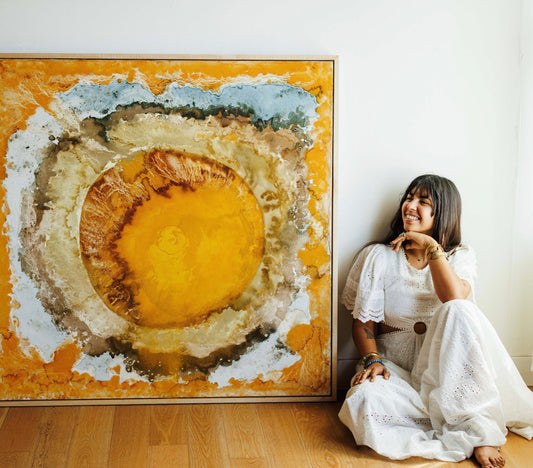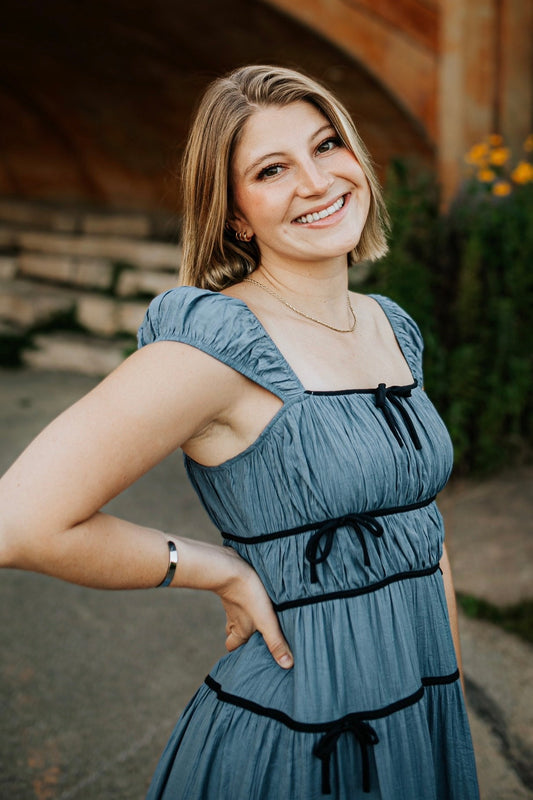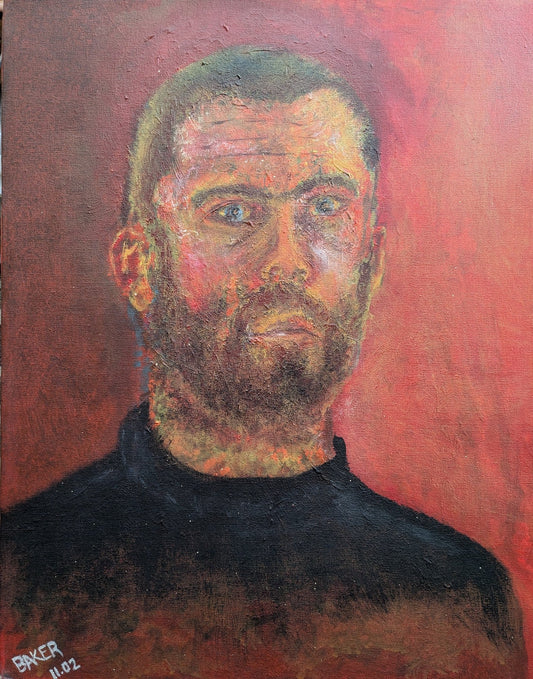Yenna Hill’s last art class was in 1999. She’s an outstanding creative with skills in Henna, line art, multimedia surface work, murals, and most recently, jewelry. The talented artist is spiritually inclined, and uses her hyper-awareness for herself and the world around her within her artwork. Yenna acknowledges that her uncle, Keith Haring, inspires her artistry, though the Haring family lineage carries a legacy of creativity. At 36, she's more dynamic and multifarious than ever—proving that while her family lineage influences who she is, it does not define her.


Education
Yenna became aware of her struggles with public education before she even reached an age that she could articulate them. While she was a part of the gifted program in elementary school, she was not excelling. Yenna recalls that she was constantly drawing in middle school and desperately wanted to be placed in art homeroom, but her teachers heavily resisted. Yenna remembers teachers telling her that, “if they let me in the art homeroom, that everybody would think it was because I had a famous artist uncle,” and they did not want her to receive special treatment. One can imagine how a young, innocent 11-year-old girl must feel when adults reject her passion, and inhibit her ability to express creative freedom.
Yenna knew the judgment was ridiculous, and it strongly impacted her aversion to public school. When Yenna and her mother, Kay Haring, explored alternative schooling, it was deemed too expensive. Partially due to her parent’s divorce at a young age, they could not afford many of the options. Yenna’s struggle to achieve good grades also impacted her ability to receive a scholarship for higher education until she found solace at Milton Hershey.
Aged 15, Yenna attended boarding school at Milton Hershey, in Hershey, PA. Yenna discussed that the school offered a private education for lower-income families, and went on to reveal that, “going there saved my life. As soon as I went there, I got diagnosed with ADHD, and started getting treated for it. I was on the honor roll, and now, the people that I went to that school with are my family.” Here, she dove into theater, drama, and acting classes as her art, as she rejected her career for being an artist after her sad experience in middle school.
After graduating from Milton Hershey, Yenna decided to move back home to Reading, knowing that college was not the right move for her at the time. She jumped into her career as an artist, where she was forced to meet deadlines and maintain a busy schedule to make a living.
Artwork
Yenna’s work is highly unique and distinguishable as hers. It is captivating the way she views her work as “represent[ing] the time capsule of when they were created.” To fully understand Yenna and her multifaceted talent, let’s explore the different ways she uses art to express herself.
Henna
When her younger daughter was little, Yenna began body and face painting, though she no longer practices—so instead, she does henna. She cites that it helps her with being a faster artist, and reminds her to consistently work with new material to learn how things evolve. Yenna is picky about when and with whom she practices her henna, in which the energetic exchange represents spiritual connection, and it is far more powerful when it is chosen and intentional. She began doing henna when her friend from boarding school opened up a henna shop in Maui and invited Yenna to come out to the island and hang her artwork in the shop because of their aesthetic similarities. Her performance of henna is based on the significance of human connection.
Wood-Cut Panels
Yenna works with several different mediums, including custom wood-cut panels that can be up to 16-inches tall. While they are small and time-consuming, they are compelling. Yenna primarily works with paint markers, and working on wood panels enables her to work with paintbrushes and acrylic, noting that it is a form of self-education.
Night Sojourn is one of her favorite pieces, which is equal parts paint marker to the paintbrush. She began by treating and priming the wood panel to ensure the layers atop remained intact. Yenna then sketched shapes with a pencil as they came to her. She color-blocked the hills in black lines with a paintbrush and Liquitex tubes, which don’t have to be mixed with water, and are immediately smooth. She remembers being scared of messing up the sky, because nobody taught her how to create light with paint. The meaning behind the piece is “about having to drive to the Midwest three times last year—I had a solo show in Illinois. And this is definitely about the number of times—there was one drive back that was really really difficult because we kept getting stuck in traffic and it was supposed to be a 12-hour drive and ended up being almost 24, and I was like sleeping in traffic on the highway.”
This piece also symbolizes Yenna’s self-taught journey with using a paintbrush. While surprised that it hasn’t sold, it is also one of her longest-held pieces, and she contemplates selling it or waiting for the right person to come along. She finds this idea fascinating, that “somebody's going to come and connect so hard and need it.”


The piece titled Everything I Went Through Will Be Beautiful is inspired by the lyrics of Jill Scott’s song, “When I Wake Up.” In times of distress, and especially through the pandemic, one of Yenna’s hacks for pressing the mental restart button is to take a nap, and says that she takes a liking to the idea that when one wakes up, lessons will have been learned. Besides the connection to the literal lyrics, Yenna explains that the piece truly ended up relating to a long series of life’s trials and tribulations. She doesn’t always explain what she goes through in her paintings, but she works between the lines of anxiety, when it smooths out and finds self-control. It is meant to express the flaws of being human, and what is not always positive, while putting good energy into her work.
Yenna strays away from using regular canvases. Her Doorway Blessings series is based on painting everything that she has in her possession already, including a brown paper bag of 37 pieces of wood. One Saturday night, Yenna began to drill holes in the back of them to see if they were able to hang easily on a simple nail. Her daughter, who periodically enjoys helping Yenna in the studio, was particularly interested in helping Yenna paint the pieces of wood and completed most of the backgrounds in the series.
After coming up with a raffle idea associated with the series, Yenna began to draw faces, eyes, and mask-like figures onto the woodcuts. Her mindset is based in spirit and the consumer, for which “people like representation of things and they like to assign power to things. They like idols, they like gods, they like energy, and they like magic.” Yenna is in fact a certified level-two Reiki, and while painting the series she confided in her Reiki teacher when she did not feel powerful. Her teacher responded that the power is in one’s intention. Thus, the series represents a shift in how Yenna explains her artwork to people.


Murals
Yenna asked her grandfather to paint a mural with her. She assumed that he had painted on walls before, citing that he had painted anything and everything. But, after the first night of them working together, he posted an image on his Instagram, captioned, “finally got to paint a mural #bucketlist.” He came out and painted every single day.
One day, it was just the two of them painting, and they were both silent. On the perfectly slight-winded October day, Yenna reflected on how she was painting on the street that her mother grew up on, and she imagined there must have been so many of these beautiful days. She then broke the silence, and asked her grandfather what year he retired, to which he responded “the end of 1989.” Yenna immediately realized that he retired two months before his son Keith died. In an emotional reliving of the full circle moment, she remembers her thinking, “he retired because he had to deal with his son dying. And he [Keith] was 31, and I’m 36.” Her connection to her grandfather is everlasting, as well as to her late uncle Keith.
Ancestral Impact
A recurring theme in Yenna's artwork is ancestry, which makes sense because the Haring family is rooted in creativity. Her grandfather is a major influence to her, as she looks up to him with intense adoration and respect voicing her "inability to comprehend what it is like to be as wonderful as he is." As an audience, we see the talent pass through each member starting with her grandfather, then to Keith and Kay, then to Yenna, and even now as her own daughter is displaying an affinity toward art. This motif of ancestry and heritage is a central mechanism for Yenna's work, and we see this in Doorway Blessings and her mural for Young One’s Records.
One of Yenna’s instagram pages, @imakethingswithmyhands, eloquently states in the bio that her work can be categorized as “pop-infused ancestral hieroglyphic art.” Yenna is self-taught, but is not a street artist, so identifying herself as such never sat right. The pop-infused phrase came into play because Yenna does not strictly consider herself a pop artist either. She explained that while she works for commission, she also makes things that she finds people unexpectedly identifying with.
The word “ancestral” holds a highly significant meaning close to Yenna’s heart. She wants to begin professionally incorporating the phrase “Haring Family Hieroglyphs," but her hesitation comes from the general idea people have—that she became an artist because of her uncle, Keith Haring. But Yenna debunks this with her attitude that “Keith did it, my uncle did it. Anybody can do it… But really it is because of my grandfather. And he taught us both to draw. And it's not just him. Everybody in the Haring family makes stuff, it's not always paintings, but people are really creative.” She remains close with her extended aunts and uncles, who show her the utmost support for her work, and who are also creatives in their own meaning of the word.
“Hieroglyphic” also works towards the importance of ancestry, as well as the idea that she is not an artist because of Keith. In her mind, “They won’t call it like Keith’s artwork if I am creating my own line, my own language.” While it is important to Yenna that she does not mimic Keith’s work, she is often surprised by technical similarities that arise with the sudden flick of the wrist. But this applies to her whole family, saying that sometimes when she writes a “j,” it reminds her of her grandmother’s handwriting, but randomly like her mother’s. Symbology can be a synonym for hieroglyphics, in which she incorporates symbols that you can also find in Keith’s work, where they sometimes are heavily doused in meaning, and others not.


Inner Art Logic
After Yenna’s heartbreaking experience in middle school that caused her to reject the future of being an artist, she went through a phase of also rejecting the fact that she is related to the legendary pop-artist of the 1980s, Keith Haring.
She recalls that when she was around 12, she did not want to be associated, branded, or symbolized with anything, saying, “I think I just had to sort out what parts I didn't want, and then as I've gotten older, I'm like, actually, like, ‘let me make up for that,’ because I'm proud…and I want people to see his images and I want to see people that tell me that they like him.”
Yenna maintains that seeing Keith’s work everywhere has become a sort of a personal form of religious symbolism. She brings light to the different sides of her family, saying that her father’s side is excessively Christian, whereas her mother’s side is dedicated to Keith. Yenna explains,
“Keith’s omnipresent there-not-there image to me goes along with patriotism and God.”
Pertaining to what she may say is an over-compensation for her previous rebellion is her adoration for Keith’s work in the form of clothing and tattoos. When she grew out of her rejection for his work, she felt that wearing his work and branding herself with Keith’s figures “felt like wearing an American flag, it felt like being patriotic to my country.”
During an interview with Yenna’s mother, Kay, she said of Yenna, “Not that she has denied being related to Keith, but she never wanted to use his name as a way of promoting herself or her artwork.” Upon asking Yenna to expand, she detailed that she acknowledges being Keith’s niece, and how it has impacted career, for the reason of not wanting to deflate his impact on her, her family, and the greater art world. Ultimately, people should care about Yenna’s art because it is good, not because of who she is related to.
Yenna discusses a beautiful anecdote in relation to her current spiritual connection to Keith on personal, ancestral, and artistic levels.
“For forever, I’ve had this image in my head of a black and white checkered floor with paint splatters. It caused me to play with patterns. It caused me to play with colors and patterns. I had no clue though where this picture came from, until I went to the [Keith Haring] Foundation in 2013. And I was like, ‘it’s Keith’s paint splatters on the floor of his old studio.’ And that's that image that has lived in my head forever. Sometimes I don't know where these things come from, which revealed a lot to me about myself too because I was like, ‘This is wild’. I have this image in my head and I never just thought it was something I liked. I thought it was something I didn't know. Maybe I saw it somewhere. And yes, I did. But whoa, it's Keith’s and I didn't know.”
Yenna reveals that her inner art logic also aligns with Kenny Sharf in a similar way, mainly because he was contemporaries with her uncle. To Yenna, it has always been logical to paint on things if they were going to be thrown away, they shouldn’t because it would make great canvases. When she found Sharf on Instagram and reconnected with him, it made the utmost sense to her why she loves “trash art.” Everything Yenna saw in her younger years was related to Keith and Sharf and correlates to her current artwork, most of the time subconsciously. For example, her Saint Statues spray painted collection from 2015 that is a direct tribute to Keith and Sharf. She recalls that it was something she just did, but realized that it exists in her mind because of her uncle. Oftentimes she is told by their friends that being around her is like being around Keith.


What's Next
Yenna’s latest venture is a jewelry line, where she has learned to acid-etch in silver and physically make necklaces by hand. The line is close to her heart, as she reminisces back to when her grandfather would fix her and his daughters’ jewelry. Yenna’s work is outstanding, and she expresses pride for her evolution as an artist and where her work stands now. She continues to create every day, always inspired by her ancestry, and constantly expanding her technique through new mediums. Her relationship with her uncle has taught her deep lessons about herself, often expressed through her artwork, and she leans into the beauty of her creative family lineage.
Personal: @yennakills
Art: @imakethingswithmyhands
Henna: @yennadoeshenna
Jewelry: @yenxmade
Websites
https://yennakills.bigcartel.com/
YEN x MADE Jewelry
©ArtRKL™️ LLC 2021-2023. All rights reserved. This material may not be published, broadcast, rewritten or redistributed. ArtRKL™️ and its underscore design indicate trademarks of ArtRKL™️ LLC and its subsidiaries.





